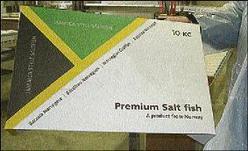
An example of the new packaging material that Ove Godo, general manager of the Atlantic Group is hoping to use for saltfish shipped to Jamaica.RIGHT: Atlantic bag.
This is the second of a two-part feature on saltfish from Norway.
One could easily say saltfish is in his blood. After all, as a boy, Ove Godo worked in the codfish factory he now owns.
He employs 10-15 persons depending on the work load at an expanding factory where saithe is dried and shipped to Jamaica and other countries.
"I export over 50 per cent of what I produce to Jamaica and have been doing so since 2000," Godo told The Gleaner on a tour of his factory.
There were signs of expansion as the family run company gets ready to do more business. They are putting in new equipment such as a modern drying room.
"The expansion is to accom-modate increased efficiency and strength to four times our present capacity, so we will have two new cold rooms," he said.
Visits Jamaica

Ove Godo, of Atlantic Group, is proud that the salted saithe he produces in his factory is part of our national dish; his packaging says it clearly.
- Photos by Barbara Ellington
Godo who has been visiting Jamaica regularly on business, is so proud of his collaboration that he reflects it with two of the boxes used to package our saltfish. The label on one box includes the line "a component of a national dish".
In fact, he wanted to know when ackee exports would begin again (website monitors take note).
"I used to see ackee at a store in Alesund, but when I recently checked the Internet, I found out it was no longer available," he said expressing his love for Jamaica's national dish.
If ever there were an opening for ackee exports, this is it.
But a great source of pride for Godo is that he now owns the factory that was established in 1952 by one family, who held it till 1999 when he acquired it. He now has two locations.
He knows that Jamaicans have been eating saltfish since the 1700s.
The Dutch introduced saltfish to the world and Germany, Switzer-land, France, Brazil, Portugal, Greece and Jamaica are among the major users.
Godo sells Jamaica salted saithe at US$5 per kilo.
He told The Gleaner that he would like to see a state-of-the-art cooling facility in Jamaica that can keep saltfish for up to a year. The product does best at home if refrigerated. The drier, the better, rather that the moist condition under which it is kept in shops and wholesale outlets.
The Atlantic Group handles seafood export, ship brokering, management of vessels and crew, packaging, public cold storage and ship consultancy.
How saltfish is processed

Fish is caught from icy cold water.
Heads are removed; fish is split and liver and roe taken out.
Backbone is removed, and assisted by machines, workers apply salt, then pack fish in huge bins, and ship or transfer to drying locations.
Some of the fish is dried in an unsalted state outdoors in the freezing cold over wooden logs.
Fish is graded and packed then placed to dry into tunnels.
Fish is sorted, weighed according to market preference and packed into boxes, then shipped every week from Norway.

